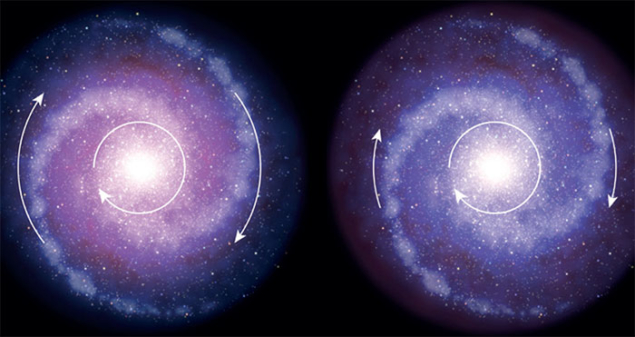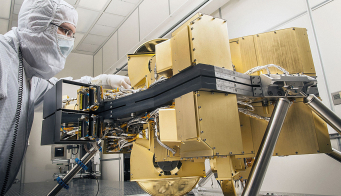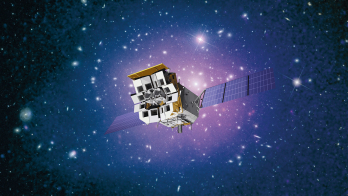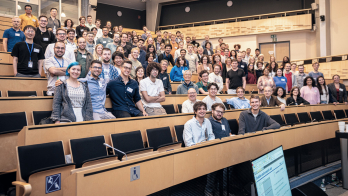
Image credit: ESO/L Calçada.
New observations using ESO’s Very Large Telescope (VLT) in Chile indicate that massive, star-forming galaxies in the early universe were dominated by normal, baryonic matter. This is in stark contrast to present-day galaxies, where the effects of dark matter on the rotational velocity of spiral galaxies seem to be much greater. The surprising result, published in Nature by an international team of astronomers led by Reinhard Genzel at the Max Planck Institute for Extraterrestrial Physics in Germany, suggests that dark matter was less influential in the early universe than it is today.
Whereas normal matter in the cosmos can be viewed as brightly shining stars, glowing gas and clouds of dust, dark matter does not emit, absorb or reflect light. This elusive, transparent matter can only be observed via its gravitational effects, one of which is a higher speed of rotation in the outer parts of spiral galaxies. The disc of a spiral galaxy rotates with a velocity of hundreds of kilometres per second, making a full revolution in a period of hundreds of millions of years. If a galaxy’s mass consisted entirely of normal matter, the sparser outer regions should rotate more slowly than the dense regions at the centre. But observations of nearby spiral galaxies show that their inner and outer parts actually rotate at approximately the same speed.
It is widely accepted that the observed “flat rotation curves” indicate that spiral galaxies contain large amounts of non-luminous matter in a halo surrounding the galactic disc. This traditional view is based on observations of numerous galaxies in the local universe, but is now challenged by the latest observations of galaxies in the distant universe. The rotation curve of six massive, star-forming galaxies at the peak of galaxy formation, 10 billion years ago, was measured with the KMOS and SINFONI instruments on the VLT, and the results are intriguing. Unlike local spiral galaxies, the outer regions of these distant galaxies seem to be rotating more slowly than regions closer to the core – suggesting they contain less dark matter than expected. The same decreasing velocity trend away from the centres of the galaxies is also found in a composite rotation curve that combines data from around 100 other distant galaxies, which have too weak a signal for an individual analysis.
Genzel and collaborators identify two probable causes for the unexpected result. Besides a stronger dominance of normal matter with the dark matter playing a much smaller role, they also suggest that early disc galaxies were much more turbulent than the spiral galaxies we see in our cosmic neighbourhood. Both effects seem to become more marked as astronomers look further back in time into the early universe. This suggests that three to four billion years after the Big Bang, the gas in galaxies had already efficiently condensed into flat, rotating discs, while the dark-matter halos surrounding them were much larger and more spread out. Apparently it took billions of years longer for dark matter to condense as well, so its dominating effect is only seen on the rotation velocities of galaxy discs today.
This explanation is consistent with observations showing that early galaxies were much more gas-rich and compact than today’s galaxies. Embedded in a wider dark-matter halo, their rotation curves would be only weakly influenced by its gravity. It would be therefore interesting to explore whether the suggestion of a slow condensation of dark-matter halos could help shed light on this mysterious component of the universe.







